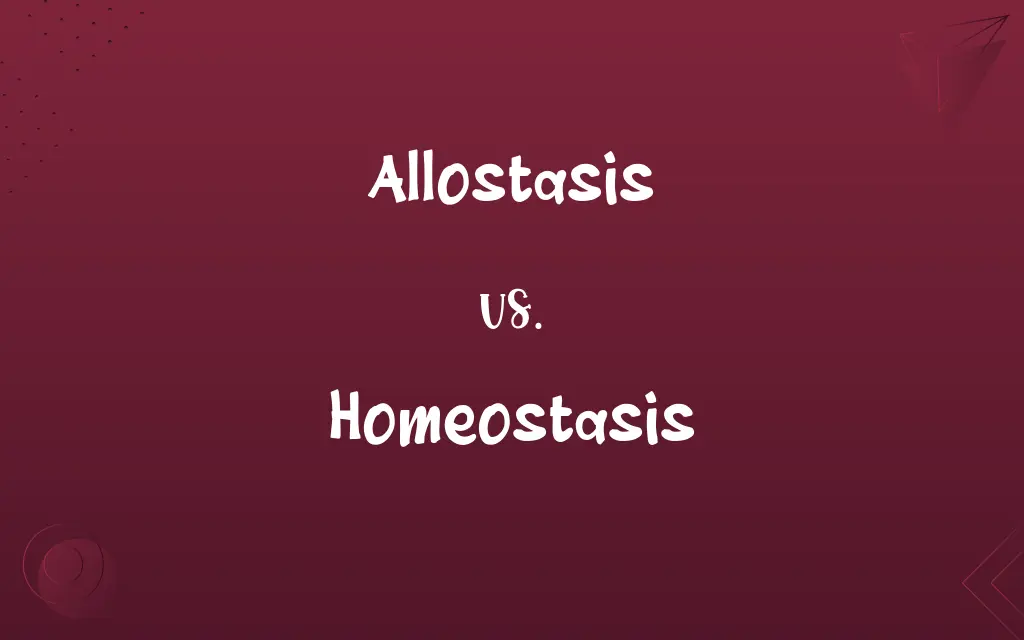Allostasis vs. Homeostasis: Know the Difference

By Shumaila Saeed || Updated on December 25, 2023
Allostasis is the process of achieving stability through physiological or behavioral change, while homeostasis maintains stability through constant internal conditions.

Key Differences
Allostasis refers to the body's adaptive mechanisms to anticipate needs and prepare for change, constantly adjusting to new circumstances. Homeostasis, on the other hand, aims to maintain internal balance and stability in response to external and internal changes, seeking to keep various physiological parameters constant.
Shumaila Saeed
Nov 26, 2023
In allostasis, the body's response systems like the endocrine and nervous systems are actively involved in predicting what the body needs and adjusting accordingly. Homeostasis, in contrast, is more about maintaining a 'status quo' in the body's systems, like temperature and pH levels, through feedback mechanisms.
Shumaila Saeed
Nov 26, 2023
Allostasis is characterized by the body’s dynamic response to external stressors and anticipates future needs, thereby adjusting its physiological processes. Homeostasis focuses on maintaining equilibrium and ensures the body's systems function within a narrow range, reacting to deviations from this range.
Shumaila Saeed
Nov 26, 2023
The concept of allostasis includes the cost of the body's adaptive processes, known as allostatic load, which can impact health over time if the body is constantly adapting to stress. Homeostasis does not account for this long-term impact, as it is concerned with immediate and short-term stability.
Shumaila Saeed
Nov 26, 2023
Allostasis emphasizes the body's proactive and anticipatory adjustments to various conditions for optimal functioning. Homeostasis, in contrast, is a reactive process, where the body responds to changes in order to maintain a stable internal environment.
Shumaila Saeed
Nov 26, 2023
ADVERTISEMENT
Comparison Chart
Objective
Achieves stability through change and adaptation.
Maintains stability through constant conditions.
Shumaila Saeed
Nov 26, 2023
Response to Stress
Anticipates and adjusts to stress.
Reacts to stress to maintain balance.
Shumaila Saeed
Nov 26, 2023
Mechanisms
Involves dynamic physiological adjustments.
Relies on feedback mechanisms for equilibrium.
Shumaila Saeed
Nov 26, 2023
Long-term Impact
Can lead to allostatic load affecting health.
Focuses on immediate and short-term stability.
Shumaila Saeed
Nov 26, 2023
ADVERTISEMENT
Allostasis and Homeostasis Definitions
Allostasis
Allostasis is the process of achieving stability through change.
When moving to a high altitude, allostasis helps your body adjust to lower oxygen levels.
Shumaila Saeed
Nov 20, 2023
Homeostasis
Homeostasis is the maintenance of a stable internal environment.
Sweating to cool down during a workout is an example of homeostasis.
Shumaila Saeed
Nov 20, 2023
Allostasis
Allostasis is the body's anticipatory response to future demands.
Allostasis occurs when athletes train their bodies for endurance before a marathon.
Shumaila Saeed
Nov 20, 2023
Homeostasis
Homeostasis is achieved through feedback mechanisms.
Shivering in cold weather to generate heat is a homeostatic response.
Shumaila Saeed
Nov 20, 2023
Allostasis
Allostasis is the dynamic process of bodily adjustment.
In allostasis, your body adjusts its immune response during flu season.
Shumaila Saeed
Nov 20, 2023
ADVERTISEMENT
Homeostasis
Homeostasis maintains constant internal conditions.
Homeostasis regulates your body's pH level to stay relatively constant.
Shumaila Saeed
Nov 20, 2023
Allostasis
Allostasis represents the cost of chronic stress.
Chronic work stress can lead to high allostatic load, demonstrating allostasis.
Shumaila Saeed
Nov 20, 2023
Homeostasis
Homeostasis involves regulating physiological balance.
Homeostasis keeps your blood sugar level within a normal range after eating.
Shumaila Saeed
Nov 20, 2023
Allostasis
Allostasis involves the body's adaptation to stressors.
Allostasis explains how students adapt to the stress of exams.
Shumaila Saeed
Nov 20, 2023
Homeostasis
A state of equilibrium, as in an organism or cell, maintained by self-regulating processes
The kidneys maintain homeostasis in the body by regulating the amount of salt and water excreted.
Shumaila Saeed
Oct 19, 2023
Allostasis
The process of achieving stability, or homeostasis, in the body, through physiological or behavioral change.
Shumaila Saeed
Oct 19, 2023
Homeostasis
(physiology) The ability of a system or living organism to adjust its internal environment to maintain a state of dynamic constancy; such as the ability of warm-blooded animals to maintain a stable temperature.
Shumaila Saeed
Oct 19, 2023
Homeostasis
The ability and tendency of certain systems to maintain a relatively constant internal state in spite of changes in external conditions; this ability is achieved by the presence of feedback mechanisms which can adjust the state of the system to compensate for changes in the state caused by the external environment. It is exemplified in homeothermal biological systems, such as animals which maintain relatively constant blood temperature and composition in spite of variations in external temperature or the composition of the food ingested.
Shumaila Saeed
Oct 19, 2023
Homeostasis
Metabolic equilibrium actively maintained by several complex biological mechanisms that operate via the autonomic nervous system to offset disrupting changes
Shumaila Saeed
Oct 19, 2023
Homeostasis
Homeostasis is essential for organism survival.
Homeostasis ensures that your body temperature doesn't fluctuate drastically.
Shumaila Saeed
Nov 20, 2023
Repeatedly Asked Queries
What is homeostasis?
Homeostasis is the regulation of the body’s internal environment to maintain a stable, constant condition.
Shumaila Saeed
Nov 26, 2023
What role does allostasis play in stress response?
Allostasis prepares and adjusts the body to handle and anticipate stress, changing physiological processes accordingly.
Shumaila Saeed
Nov 26, 2023
How does homeostasis affect pH levels in the body?
Homeostasis regulates pH levels by balancing acids and bases to maintain a neutral environment.
Shumaila Saeed
Nov 26, 2023
How does homeostasis regulate body temperature?
Homeostasis maintains body temperature through mechanisms like sweating or shivering to counteract external temperature changes.
Shumaila Saeed
Nov 26, 2023
What is the main goal of homeostasis?
The main goal of homeostasis is to keep the body's internal environment stable and consistent.
Shumaila Saeed
Nov 26, 2023
Can allostasis have negative effects?
Yes, prolonged allostasis can lead to allostatic load, causing wear and tear on the body due to chronic stress.
Shumaila Saeed
Nov 26, 2023
Is homeostasis a static process?
No, homeostasis is a dynamic process that constantly adjusts internal variables to remain within a stable range.
Shumaila Saeed
Nov 26, 2023
How does allostasis differ from homeostasis?
Allostasis involves adaptation and change for stability, while homeostasis maintains stability through consistent internal conditions.
Shumaila Saeed
Nov 26, 2023
What is allostasis?
Allostasis is the process by which the body achieves stability through change, especially in response to stress.
Shumaila Saeed
Nov 26, 2023
Does allostasis only respond to negative stress?
No, allostasis responds to both positive and negative stress, adapting the body accordingly.
Shumaila Saeed
Nov 26, 2023
What are some common examples of homeostatic processes?
Regulation of blood sugar, body temperature, and water balance are common examples of homeostatic processes.
Shumaila Saeed
Nov 26, 2023
Is homeostasis more important than allostasis?
Both processes are vital; homeostasis maintains stability while allostasis allows for adaptability.
Shumaila Saeed
Nov 26, 2023
What is an example of allostasis in everyday life?
Adjusting to a new work schedule by altering sleep patterns is an example of allostasis.
Shumaila Saeed
Nov 26, 2023
How do feedback loops work in homeostasis?
Feedback loops in homeostasis involve sensors detecting a change and effectors correcting it to maintain balance.
Shumaila Saeed
Nov 26, 2023
Can allostasis and homeostasis work together?
Yes, these processes often work in tandem, with allostasis preparing the body for change and homeostasis maintaining balance.
Shumaila Saeed
Nov 26, 2023
Why is allostasis important?
Allostasis is crucial for survival as it enables the body to adapt to different stressors and challenges.
Shumaila Saeed
Nov 26, 2023
Can homeostasis fail? What happens then?
Yes, failure of homeostasis can lead to illnesses or disorders due to the imbalance of the body's systems.
Shumaila Saeed
Nov 26, 2023
How does the nervous system relate to allostasis?
The nervous system plays a key role in allostasis by signaling the body to adapt to various stressors.
Shumaila Saeed
Nov 26, 2023
What factors can affect allostasis?
Factors like environmental changes, lifestyle, and psychological stress can significantly affect allostasis.
Shumaila Saeed
Nov 26, 2023
How do hormones relate to allostasis?
Hormones are integral to allostasis, facilitating bodily adjustments in response to stressors.
Shumaila Saeed
Nov 26, 2023
Share this page
Link for your blog / website
HTML
Link to share via messenger
About Author
Written by
Shumaila SaeedShumaila Saeed, an expert content creator with 6 years of experience, specializes in distilling complex topics into easily digestible comparisons, shining a light on the nuances that both inform and educate readers with clarity and accuracy.






































































